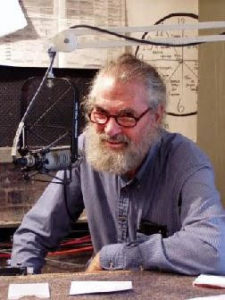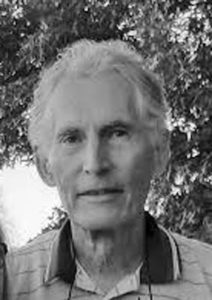
Dave showing off the downtown Champaign Pocket Prairie
David Monk, 91, died on December 2, 2022. For a detailed account of his life and accomplishments, refer to the News-Gazette article published on July 13, 2022, soon after he went into hospice care. It is not easy to summarize this man’s amazing life and activities. Readers may know of Dave and his important place in local environmental activity. Many people applauded the brown-cloaked Monk annually pulling a wagon of prairie plants during Fourth of July parades. His Pocket Prairies attracted curious visitors, some of whom became prairie advocates. We were among numerous friends who frequently visited him during his last six months. He didn’t complain. His ideas about future projects were his constant concerns, and he encouraged everyone to get involved and basically save the world! He would talk about prairie remnants in the area that we needed to visit and get local people involved in preserving them. His conversations and knowledge about East Central Illinois geography, railroad activities, and rural and urban histories were encyclopedic.
Dave was not ready to go. He wanted to do more, to keep up the struggle to save prairie and instill an environmental ethic in our thinking and actions. He once said, when we proposed working on a new prairie project, “Don’t mention Monk – I’m too controversial.” He was well aware of his uncomfortable effect on some people, and that because he questioned the status quo, he would experience pushback and sometimes ridicule. But he was persistent in his efforts and always looked beyond obstacles to what might be possible if people worked together.
His advocacy for prairie preservation, art, and multidisciplinary approaches to environmental issues began in the early 1960s, while he was an Australian graduate teaching assistant in botany at the University of Illinois. In 1963 he earned a master’s degree in education. During this time, he worked for Allerton Park documenting natural features and developing interpretive materials. In 1969, while working with several U of I departments, Dave formed the Natural Areas Instructional Development group. When funding ended, he renamed the group Educational Resources in Environmental Science (ERES), and shortly thereafter moved off campus. ERES developed and provided environmental education materials for teachers and students at the U of I and local schools. He encouraged learning through art, silkscreen printing, and photography. Dave believed that contact with nature is important. To experience the landscape, he provided guided prairie tours throughout Champaign and Piatt Counties. He established and taught “Reading the Landscape” at Parkland College and served for several summers as a visiting lecturer at the Chicago Art Institute, where he taught “Artist in the Landscape.”
Dave was a proponent of interagency cooperation and intergovernmental agreements. He worked with others in the early 1970s to save Busey Woods from being converted into an industrial site, and the woodland is today a treasured natural area of the Urbana Park District (UPD). He helped save, and with Champaign County Historical Museum, conducted the move of the Greek Revival Cottage that today is the administrative UPD office. He played a role with others in the formation of Grand Prairie Friends, and he worked with the Champaign County Design and Conservation Foundation to develop the Kickapoo Rail Trail, now owned and managed by Champaign County Forest Preserve and Vermillion County Conservation districts. Dave served constantly with on-the-ground labor and as a catalyst, encouraging involvement and bringing people and organizations together to accomplish mutual environmental goals. As a result, there were times when Dave’s important roles were unrecognized and uncredited.
Dave could be stubborn, persuasive, engaging, and inspiring—all in service of the good cause. In his daily life he lived on very little and was quite willing to go hungry, to be cold, and actually live like an ascetic monk. He devoted his limited resources to advance efforts to preserve prairie. In certain ways he was our version of the naturalist John Muir. He was our Prairie Monk.
Monk would not throw out anything. He was fiercely dedicated to recycling, reuse, and repurposing of nearly everything. His office on Market Street in Champaign served as his home and it also became a repository of prairie plants, seeds, and specimens as well as all types of cast-off items that he rescued from discard and put on display for resale or donation to good use. He wanted to lead by example. He objected to our throwaway economy designed around waste. Dave worked tirelessly to prevent more plastics and litter from polluting rivers and coastlines. His office seemed in disarray, but he lived with limited financial support while keeping extensive records of his many activities.
In 1987 he established Heartland Pathways (HP), focused on acquisitions of retired railroad line. The small amount of remaining original prairie in east central Illinois is to be found primarily on railroad rights of way. In order to save that remaining prairie, HP acquired 33 miles of retired railroad line in neighboring Piatt County that, without Dave’s efforts, would have been lost to private development. This work enabled Monticello to have some beloved pathways on former HP-acquired railbed. The mission of Heartland Pathways is continuing into the future and welcomes community support.

Dave at the mic doing his WEFT 90.1 FM radio show, “The Prairie Monk”
Dave hosted “The Prairie Monk,” a weekly radio program on WEFT 90.1 FM for many years. He talked a lot about rewilding. That is, nature healing, recovering and reclaiming land that has been altered by human activity. His concern was about the balance between recreational development and rewilding of prairie sites. He knew that public support for protecting wild places is essential and that providing trails is one way of getting people out to experience nature and thereby develop a constituency for environmental protection. But how much of nature should be damaged to provide public access for recreation when there is so little original prairie remaining? These are the types of issues that cause strife between well-meaning groups and individuals as they plan for the future. Monk’s concerns are part of an international conversation as we begin to understand the consequences of pollution, climate change, and the rush to claim and consume the planet’s resources for profit at all costs.
Dave talked with us about cultural attitudes in working with the environment. He believed, like the cultures of indigenous and aboriginal people, that humans are just one component in the web of life. He posed the question: who speaks for Nature? He wanted us to be committed and to take action in all the unfinished work. Monk was concerned that we only have a fraction of one percent of the original prairie left in Illinois. What was at one time a seemingly endless grand prairie that appeared as vast as the ocean has all but vanished in less than 200 years. Up to his final hours, David Monk was advocating for saving the last remaining remnants of original prairie that may offer genetic and microbial resources for agriculture and medicine that are as yet unrealized or undiscovered.
A memorial for Dave will be announced in the future.
In the meantime, visit some protected wild place. Breathe deeply. Listen. In late spring go to a prairie where grasses and flowering plants have emerged. Remember . . . David Monk.
Glen Martin and his wife Kathy worked with Dave Monk in the 1970s and remained friends with him throughout his life. They worked on many prairie projects including producing silkscreen prints. More info about Dave at prairiemonk.org.

Editors’ Note: the Public i published a long interview with David Monk in the June, 2018 issue.
4,413 total views, 1 views today
